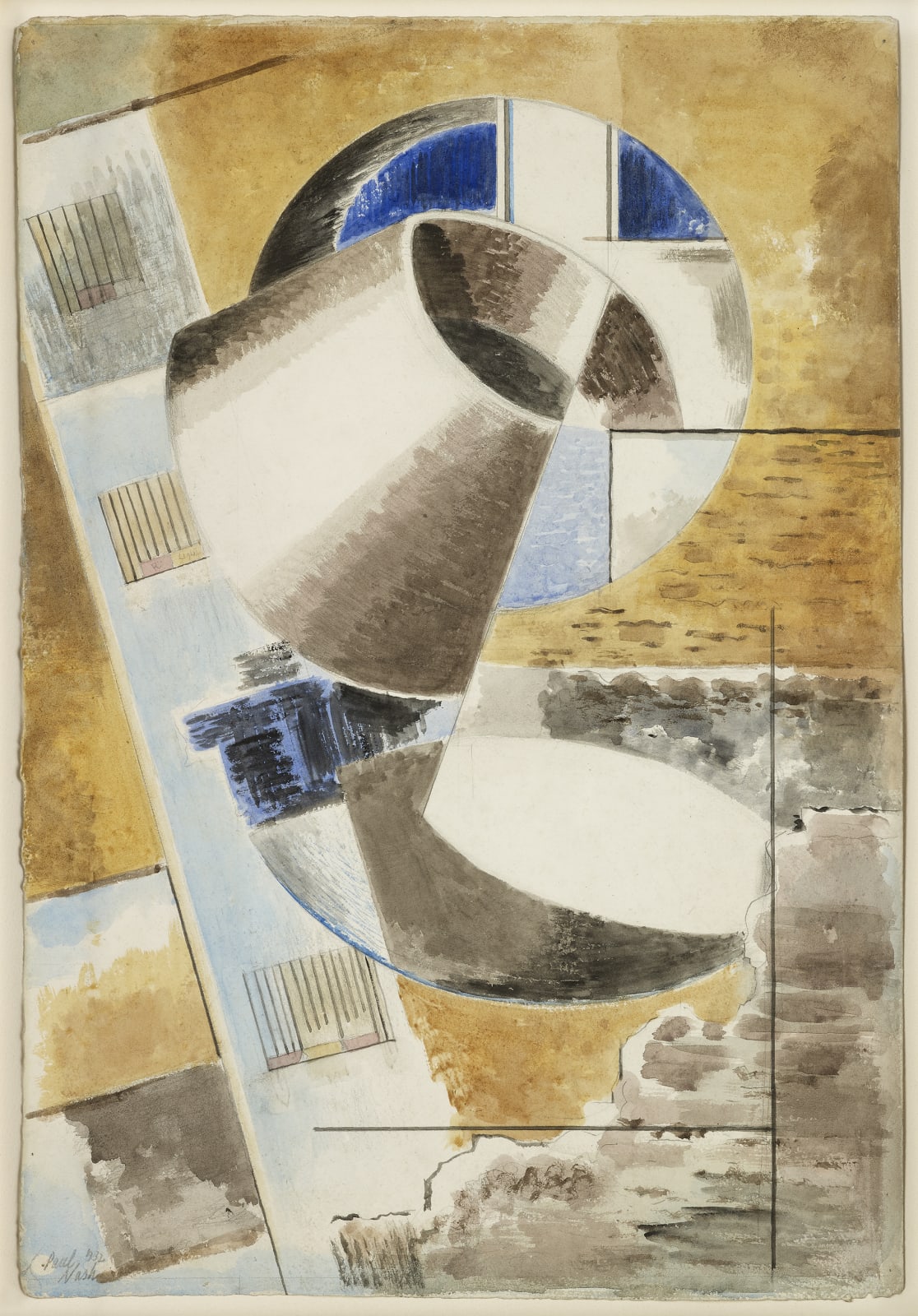Paul Nash 1889-1946
Abstraction (Rotary Objects), 1932
pencil and watercolour
22 3/4 x 15 3/4 in. / 57.8 x 40 cm
signed and dated 'Paul/Nash/1932' (lower left)
Originally titled Abstraction, this watercolour has been known since the 1950s as Rotary Objects. Created in 1932, the year before the establishment of Unit One, it was one of only...
Originally titled Abstraction, this watercolour has been known since the 1950s as Rotary Objects. Created in 1932, the year before the establishment of Unit One, it was one of only two watercolours Paul Nash contributed to the group’s legendary exhibition in 1934. The years 1930-1932 mark a pivotal moment in Nash’s career. A trip to Léonce Rosenberg's gallery in Paris in 1930, prompted him to evaluate the merits of the European Modern Movement and he began to work in a constructional and metaphysical manner that broke away from his recognised style of painting. As such, Rotary Objects and three works from the Tate’s collection, Kinetic Feature, 1931, Mansions of the Dead, 1932 and Aerial Composition, 1933, form an important body of work.
Rotary Objects shares many similarities with Mansions of the Dead, one of a series of works Nash created to illustrate Sir Thomas Browne’s literary text Urn Burial, 1658. Both sheets share a similar palette of pale ochre, blue, grey and white. The composition of Mansions of the Dead depicts a circular, disc motif, which in the present work expands and spirals through the composition. The light blue, plank-like diagonal shape in Rotary Objects is an abstracted component of the geometric structure of Mansions of the Dead, and the black horizontal and vertical lines seen here are borrowed from the other work’s ‘birdcage in the sky’.
In Rotary Objects Nash introduces a partly obscured, blue circular window suggesting an aperture connecting the spiritual world to the real, inhabited world. Clouds appear in both works, placing the compositions in a specific setting, detached from the ordinary canons of recognition, in an ‘attempt to express the sensation of being in space, in a realistic sense, and of conveying in a heightened degree the element of interpenetration.’ 1
Discussing the origins of the central motif, Andrew Causey notes that the artist’s wife Margaret ‘told the previous owner that the design was suggested by lampshades’. 2 However, the interest Nash showed in Wadsworth's 'machinery painting' at exactly this time, of which Composition, Crank and Chain, 1932 (coll. Scottish National Gallery of Modern Art) is an example, suggests that the suspended silver-coloured object which dominates this composition is more likely something mechanical. Furthermore, photographs taken on Nash’s voyages to and from America in 1931-1932, show his fascination with the ships’ architecture, particularly the funnels. These photographs and elements of Nash’s watercolour Voyage, 1932, similarly appear to have inspired Rotary Objects.
1 David Fraser Jenkins, Paul Nash The Elements, exhibition catalogue, Dulwich Picture Gallery, London, 2010, p118
2 Andrew Causey, Paul Nash, Oxford University Press, Oxford, 1980, p240
Rotary Objects shares many similarities with Mansions of the Dead, one of a series of works Nash created to illustrate Sir Thomas Browne’s literary text Urn Burial, 1658. Both sheets share a similar palette of pale ochre, blue, grey and white. The composition of Mansions of the Dead depicts a circular, disc motif, which in the present work expands and spirals through the composition. The light blue, plank-like diagonal shape in Rotary Objects is an abstracted component of the geometric structure of Mansions of the Dead, and the black horizontal and vertical lines seen here are borrowed from the other work’s ‘birdcage in the sky’.
In Rotary Objects Nash introduces a partly obscured, blue circular window suggesting an aperture connecting the spiritual world to the real, inhabited world. Clouds appear in both works, placing the compositions in a specific setting, detached from the ordinary canons of recognition, in an ‘attempt to express the sensation of being in space, in a realistic sense, and of conveying in a heightened degree the element of interpenetration.’ 1
Discussing the origins of the central motif, Andrew Causey notes that the artist’s wife Margaret ‘told the previous owner that the design was suggested by lampshades’. 2 However, the interest Nash showed in Wadsworth's 'machinery painting' at exactly this time, of which Composition, Crank and Chain, 1932 (coll. Scottish National Gallery of Modern Art) is an example, suggests that the suspended silver-coloured object which dominates this composition is more likely something mechanical. Furthermore, photographs taken on Nash’s voyages to and from America in 1931-1932, show his fascination with the ships’ architecture, particularly the funnels. These photographs and elements of Nash’s watercolour Voyage, 1932, similarly appear to have inspired Rotary Objects.
1 David Fraser Jenkins, Paul Nash The Elements, exhibition catalogue, Dulwich Picture Gallery, London, 2010, p118
2 Andrew Causey, Paul Nash, Oxford University Press, Oxford, 1980, p240
Provenance
Margaret Nash, the artist’s wifeZwemmer Gallery, London, 1957
Private Collection, USA
Exhibitions
London, Leicester Gallery, Watercolours by Paul Nash, November 1932, cat no.19, not illusLiverpool, Walker Art Gallery, Unit One Tour, May 1934, cat no.39, touring to:Rusholme, June 1934Hanley, August 1934Derby, December 1934Swansea, January 1935Belfast, March 1935 Oxford, St Hilda's College, Paintings and Watercolours by Paul Nash from the Collections of Mrs. Paul Nash and Mrs Michael Dawnay, January 1959, cat no.12
Literature
Andrew Causey, Paul
Nash, Clarendon Press, Oxford, 1980, cat no.718, illus b/w p417
David Boyd Haycock, Paul Nash, Another Life, Another World, Piano Nobile, London, 2019, cat no.23, p64, illus colour p63
Join our mailing list
* denotes required fields
We will process the personal data you have supplied to communicate with you in accordance with our Privacy Policy. You can unsubscribe or change your preferences at any time by clicking the link in our emails.



